#Plautilla Nelli
Text
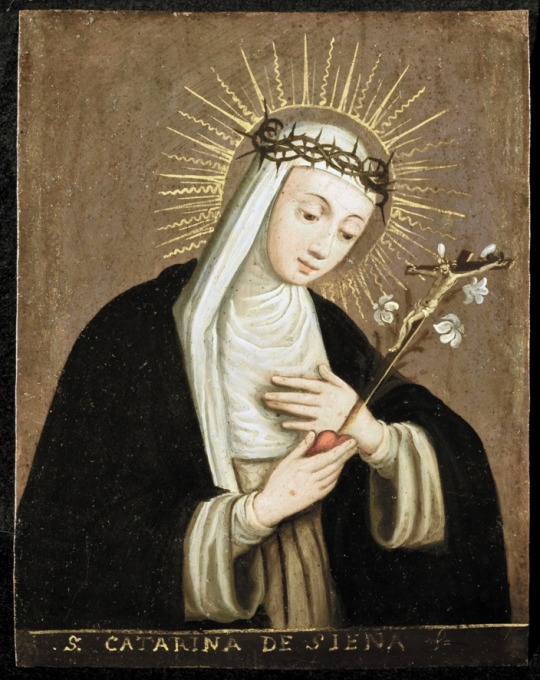
Plautilla Nelli (Italian, 1524-1588)
Santa Caterina da Siena
126 notes
·
View notes
Text
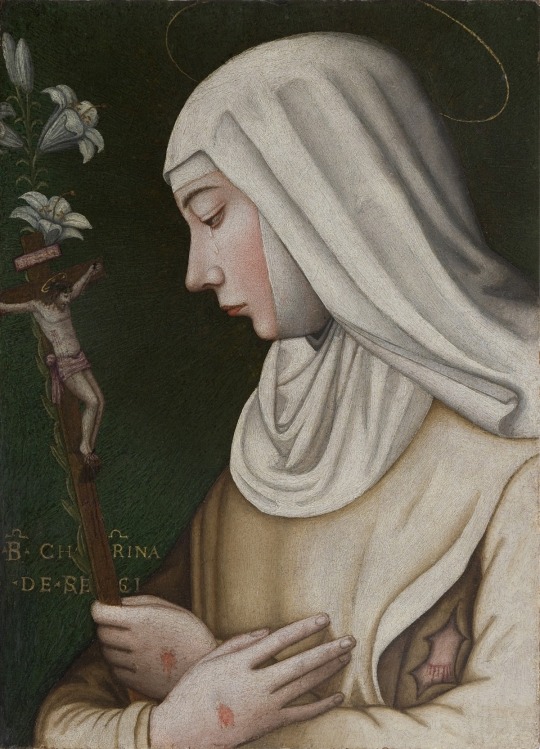
Plautilla Nelli, St. Catherine with Lily (ca. 1550). Collection of Le Gallerie Degli Uffizi, Florence.
14 notes
·
View notes
Text
Pope Francis’s August 2023 Prayer Intention: For World Youth Day
Lord Jesus, to Your most Merciful Heart
we entrust all young people that,
despite their falls, long to follow You.
The world needs Your strength,
Your enthusiasm, and Your passion.
We pray that, embracing the new life
which was given to them at baptism,
they may be prophets of new times,
able to wake up full of hope
and go out on the roads of Damascus
to bear witness to the works that You
have begun to realize in them.
Amen.
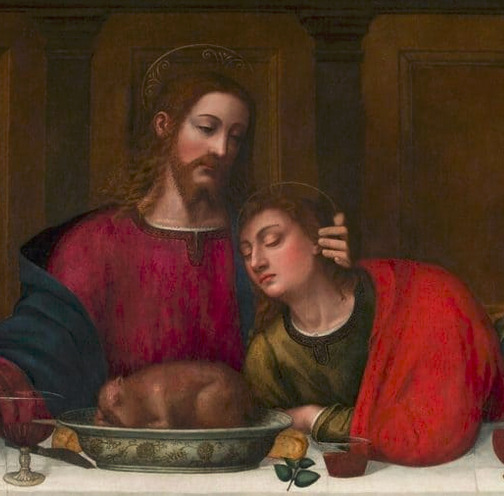
detail of The Last Supper, by Sister Plautilla Nelli, oil on canvas, circa 1568
#Christianity#Catholicism#Jesus Christ#grace#Imitatio Dei#prayers#My Pope#John the Apostle#Plautilla Nelli#Sacred Heart#Light of the World
22 notes
·
View notes
Text

"Pained Madonna"
Plautilla Nelli
#Pained Madonna#Plautilla Nelli#female artist#art history#religious painting#mannerism#late renaissance
18 notes
·
View notes
Text
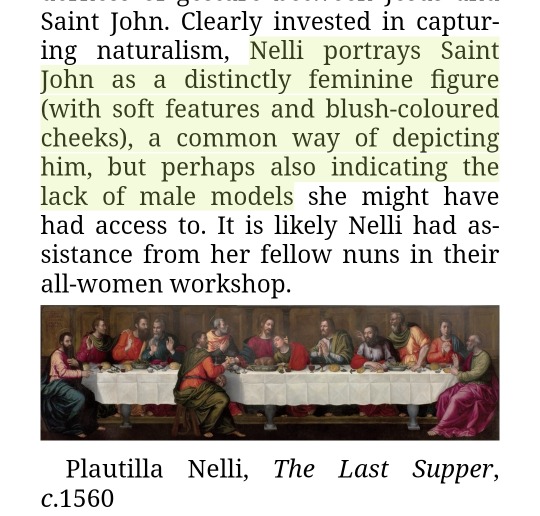
#plautilla nelli#women artists#history of art without men#renaissance art#the power of the yaoi impulse
2 notes
·
View notes
Text

Plautilla Nelli (1524 - 1588), “Santa Caterina in preghiera”.
3 notes
·
View notes
Text


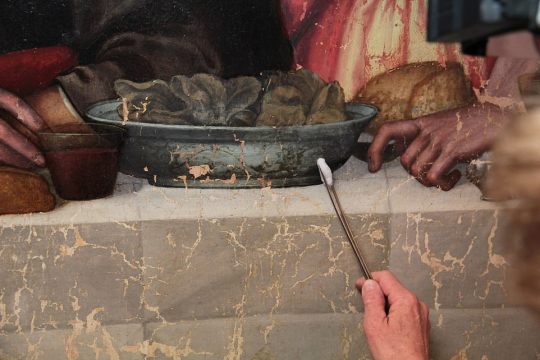
Forgotten 'Last Supper' painted by one of the first female renaissance masters is back to its former glory after 450 years thanks to painstaking four-year restoration
The painting had been hidden for decades in the refectory (dining room) of an Italian convent crumbling away
Plautilla Nelli, 1524 to 1588, was a Dominican nun and painter living in Cafaggio, Italy, and hidden in obscurity
She set up a group of nuns who could be commissioned to paint biblical scenes for churches or private clients
By Milly Vincent For Mailonline
Published: October 2019
The only the 'Last Supper' painted by a self-taught nun during the Italian Renaissance has been revealed to the public after a four year restoration.
Seven meters wide and two meters high the 450-year-old painting had been hidden for decades in the refectory (dining room) of an Italian convent enduring floods and three decades rolled up in storage.
Plautilla Nelli, (1524 to 1588) was a Dominican nun and painter who resided in the covent of Santa Caterina in Cafaggio, Italy.
The Last Supper by Plautilla Nelli, restoration - before (bottom) and finally visible (top), in the 'old Refectory' of the Museo di Santa Maria Novella in Florence
Until now her work had faded into obscurity but centuries after her death her largest surviving work will now be on display in the Museo di Santa Maria Novella in Florence.
The work was restored by the US-registered Advancing Women Artists (AWA) Foundation, which has restored 65 works by historic female artists in Florence since 2009.
Since the foundation first began to conserving sister Nelli's works around 20 pieces have now been attributed to the artist - rising from just three.
Plautilla Nelli was credited in Giorgio Vasari's 16th-century biography, Lives of the Artists, as 'a nun and now Prioress… beginning little by little to draw and to imitate in colours pictures and paintings by excellent masters'.
The Last Supper by Plautilla Nelli, restoration detail. The work was restored by the US-registered Advancing Women Artists (AWA) Foundation, which has restored 65 works by historic female artists in Florence since 2009
The Last Supper by Plautilla Nelli, restoration conservator Rossella Lari with painting 'in progress'
The Last Supper by Plautilla Nelli, restoration detail. The work was restored by the US-registered Advancing Women Artists (AWA) Foundation, which has restored 65 works by historic female artists in Florence since 2009
$187,000 was raised for the restoration of the painting- with donors 'adopting' an apostle for $10,000 each
After entering the covent of Santa Caterina in Cafaggio age 14 sister Nelli started her own company of painting nuns who could be commissioned by the church and private clients to create large biblical scenes on canvas.
It is believed she painted 'The Last Supper' in the 1560s in her late 30s.
A crowdfunding mission by AWA in 2017 £144,500 ($187,000) was raised for the restoration of the painting- with donors 'adopting' an apostle for £7,700 ($10,000) each.
Although disloyal apostle Judas was not willingly 'adopted' by a singular donor, a charitable 10 donors came together to raise the remaining £7,700 ($10,000).
Conservator Rossella Lari makes the finishing touches on The Last Supper by Plautilla Nelli
The restored Last Supper by Plautilla Nelli is put on public display in the Museo di Santa Maria Novella in Florence, Italy
The Last Supper by Plautilla Nelli, restoration after transfer to the Santa Maria Novella Museum, post-restoration
AWA's director, Linda Falcone told The Art Newspaper: 'Within these seven metres you can see different painterly hands, so it's canvas proof that she founded this all-women workshop inside her convent.'
'Orate pro pictora', pray for the paintress, is touchingly written beneath sister Nelli's signature.
Conservator Rossella Lari wrote in a catalogue for the exhibit that the piece had a 'great sense of energy and determination' and noted inconsistencies that she put down to sister Nelli's lack of formal art education.
It is unlikely sister Nelli would have been allowed to study live models as a woman and a nun - she is thought to have used manuals and other paintings to have learned the anatomy of the male apostles that she painted in detail.
A detail of the table of the The Last Supper by Plautilla Nelli, during cleaning before restoration
One of Nelli's most successful Saints in The Last Supper by Plautilla Nelli after restoration (left). Detail of the Saint's arm, most likely drawn from other paintings (right)
'Orate pro pictora', pray for the paintress, is touchingly written beneath sister Nelli's signature
https://www.dailymail.co.uk/sciencetech/article-7599783/Forgotten-Supper-painted-female-renaissance-master-former-glory-450-years.html
5 notes
·
View notes
Text
0 notes
Text
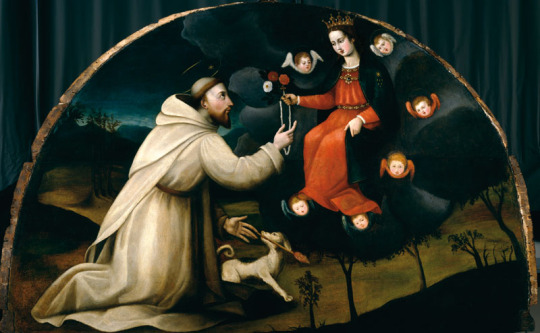
plautilla nelli. saint dominic receives the rosary.
0 notes
Text
Ladies please share to spread the word about two exhibits featuring women artists in two different cities

Artemisia Gentileschi, Self Portrait as Saint Catherine of Alexandria (ca. 1615–17). Collection of the National Gallery, London.
Renaissance art calls to mind some of the greatest names in art history—Da Vinci, Raphael, Michelangelo, and Donatello, just to name a few. Lesser known, however, are the influential women artists who shaped the era.
Referring to a period that bridged the end of the Middle Ages and early Modernism, the Renaissance was marked by a widespread effort to recover and advance the accomplishments of classical antiquity. Originating in Florence, Italy, but soon spreading throughout Europe, Renaissance art saw the advent of advanced linear perspective and an increase in realism. Many women artists—famous in their own time—were among these great visionaries.
Though for centuries, these women artists were largely overlooked in the annals of art history, contemporary scholarship has begun a long overdue reappraisal and rediscovery of their lives and works. Evidence of this resurgence of interest in the women artists of the Renaissance can be seen in the two current major museum shows in the U.S. that are dedicated to just that. “Strong Women in Renaissance Italy” at the Museum of Fine Arts, Boston brings together over 100 works from the 14th through early 17th century, exploring the lives and work of Italian women artists and is on view through January 7, 2024. At the Baltimore Museum of Art, “Making Her Mark: A History of Women Artists in Europe, 1400–1800” is a sweeping exhibition that aims to rectify critical oversight and bring awareness to historical women artists, and is also on view through January 7, 2024,.
In light of these two important exhibitions, we’ve brought together a brief introduction to five Renaissance women artists whom we think you should know.
Plautilla Nelli (1524–1588)

Plautilla Nelli, St. Catherine with Lily (ca. 1550). Collection of Le Gallerie Degli Uffizi, Florence.
Plautilla Nelli was a nun of the Dominican order at the convent of St. Catherine of Siena in Florence—and is considered by many scholars to be the first-known woman artist of Renaissance Italy. A self-taught painter, Nelli led a women’s artist workshop from the convent, and she was one of the few women mentioned in Vasari’s seminal treatise Lives of the Most Excellent Painters, Sculptors, and Architects. Because she developed her practice without formal training and was forbidden from studying male nudes, Nelli frequently copied works by other artists, as well as motifs from religious texts and sculpture.

Nelli’s work recently came into the limelight for her immense painting Last Supper, dating to 1568. Measuring over 21 feet long and 6 feet high, the painting remained in her convent’s refectory until the early 19th century, before being moved to another convent’s refectory and, ultimately, being placed in storage. Following an early 20th-century restoration and several more moves, it went on view to the public for the first time in over four centuries at the Santa Maria Novella Museum in 2019. Hanging alongside other masterworks by artists like Brunelleschi, it finally is getting the widespread recognition it deserves.
Catharina van Hemessen (1528–after 1565)
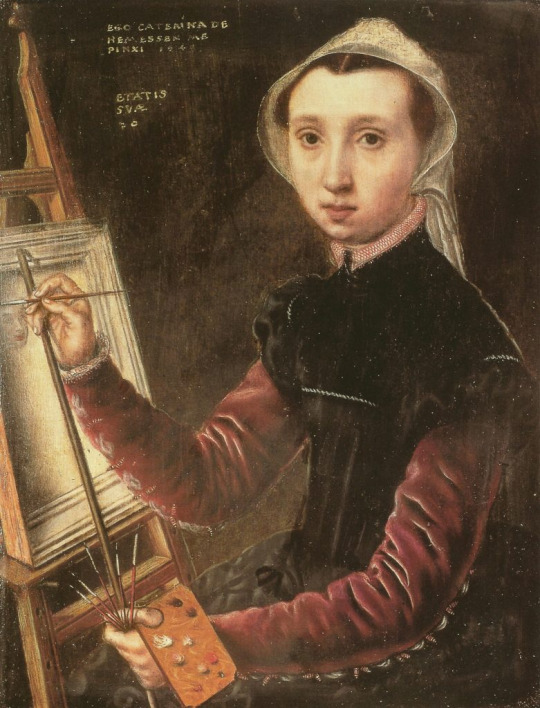
Catharina van Hemessen, Self-Portrait (1548). Collection of Kunstmuseum Basel.
Northern Renaissance painter Catharina van Hemessen was the daughter of prominent Mannerist painter Jan Sanders van Hemessen, and is the earliest Flemish woman painter with verified work that still exists today. Hailing from Antwerp, van Hemessen achieved success in her lifetime, including obtaining the patronage of Maria of Austria, regent of the Low Countries. She was included both in Vasari’s collection of artist biographies, as well as artist biographer Lodovico Guicciardini’s Description of the Low Countries (1567). Van Hemessen’s greatest claim to fame, however, is that she is attributed with completing the first known self-portrait of an artist at their easel—a compositional approach that has become a pillar of the art historical canon, as it has been taken up by artists ranging from Rembrandt van Rijn to Norman Rockwell.
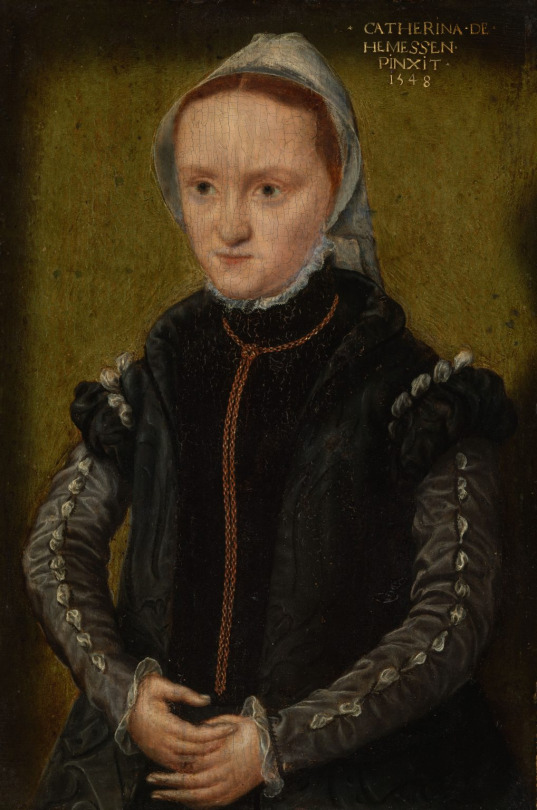
Though she created religious images, she was most well known as a portraitist. Eight portraits and two religious compositions signed by van Hemessen have survived, dating between 1548 and 1552. Notably, there are no verifiable works dating to later than 1554, which have led scholars to believe she ceased painting following her marriage to organist Christian de Morien that year—though there are records she continued to teach three male apprentices.
Sofonisba Anguissola (ca. 1532–1625)
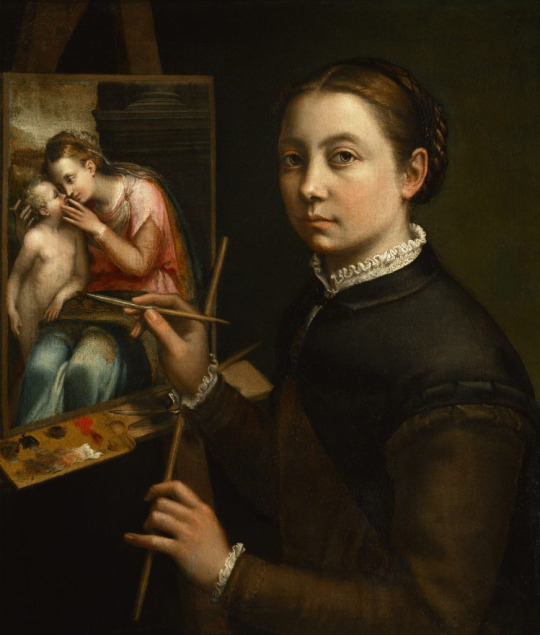
Sofonisba Anguissola, Self-portrait (ca. 1535–1625). Collection of Łańcut Castle Museum, Poland.
Sofonisba Anguissola was one of the most successful women artists of the Renaissance, with a reputation that rose to international acclaim in her lifetime. Born into a noble Milanese family, Anguissola was able to pursue her artistic aspirations with the support of her family, and began her formal training as a teenager; first apprenticing with Bernardino Campi for three years before working with Bernardino Gatti. Her position also allowed for her to become acquainted with Michelangelo, whom she exchanged drawings with. Her early career saw her complete numerous self-portraits as well as portraits of her sisters, including The Game of Chess (1555), which are noted for their realism and liveliness.

Sofonisba Anguissola, The Game of Chess (ca. 1555). Collection of the National Museum in Poznań, Poland.
Anguissola’s reputation as a painter quickly spread, and she was invited to join the court of King Philip II of Spain in Madrid in approximately 1559. Throughout her 14-year tenure there, she completed many official portraits of both members of the royal family and members of the court, adopting the formal and intricate style expected—though unfortunately, no work from this period survived due to a palace fire in the 18th century. Having garnered considerable royal favor, she ultimately spent the remainder of her life continuing to paint as well as teach and engage with young, up-and-coming artists. In 1624, one such young artist by the name of Anthony van Dyck visited Anguissola and recorded his visit in a series of sketches and noted that he learned more about the principles of painting from her than from anything else he had encountered.
Lavinia Fontana (1552–1614)

Lavinia Fontana, Self-portrait at the Spinet with Maid (1577). Collection of the Accademia Nazionale di San Luca, Rome.
Trained by her artist father Prospero Fontana, a teacher at the School of Bologna, Lavinia Fontana is considered the first professional woman artist insofar as she supported herself and her family solely on the income from her commissions. Unconventional for the time, her husband acted as her agent and took a primary role in childcare for their 11 children. She began her commercial practice in her mid-twenties, creating small devotional paintings, but later began and excelled at creating portraits—and became a favorite of Bolognese noblewomen who vied for her services. Unusual for the period, she also created large-scale mythological or religious paintings that occasionally featured female nudes.

Lavinia Fontana, The Visit of the Queen of Sheba to King Solomon (1599). Collection of the National Gallery of Ireland, Dublin.
In the early years of the 17th century, she was invited to Rome at the invitation of Pope Clement VIII and was soon appointed as an official portraitist at the Vatican, counting Pope Paul V as one of her sitters. Her career success continued to thrive, as evidenced by the numerous honors she received, and the bronze portrait medallion cast in her likeness by sculptor and architect Felice Antonio Casoni. She was also one of the first women elected to the Accademia di San Luca in Rome.
Artemisia Gentileschi (1593–1653)
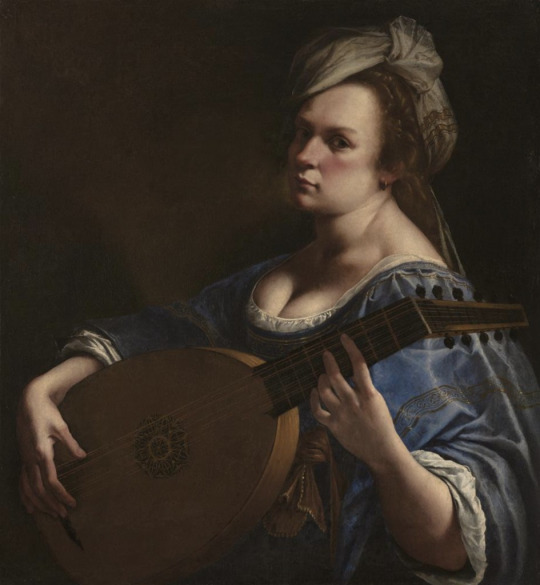
Artemisia Gentileschi, Self-portrait as a Lute Player (ca. 1615–1618). Collection of the Wadsworth Atheneum Museum of Art, Hartford.
Unlike many of her predecessors, Artemisia Gentileschi has maintained a level of renown over the centuries, with her dramatic and dynamic oeuvre that was unprecedented in her own time. Her Baroque compositions helped usher in a new era of painting. Today, her paintings draw the attention of global audiences. Born in Rome, her father was the painter Orazio Gentileschi, who trained Artemisia starting at an early age. Inspired greatly by the work of Caravaggio and his use of high-contrast compositions, her paintings garnered and maintained attention for their naturalism and nuance, as they broke from the idealism of generations past.

Artemisia Gentileschi, Judith and Her Maidservant with the Head of Holofernes (ca. 1623–1625). Collection of the Detroit Institute of Arts.
In 1612, Gentileschi relocated to Florence, which is where she first achieved major career success, including securing patronage from the House of Medici and being the first woman to attend the Accademia delle Arti del Disegno. From her oeuvre, Gentileschi has become most well-known for her self-portraits as well as religious scenes, specifically the story of Judith Beheading Holofernes—of which there are at least six known variations she completed. Gentileschi’s tendency to portray women as the protagonists of her works—and as equals to their male counterparts—made her innovative in her time and has subsequently secured her legacy as one of the most influential artists within Western art history—of either sex.
#Women in Art#Strong Women in Renaissance Italy#Museum of Fine Arts#Boston#There until January 7 2024#Making Her Mark: A History of Women Artists in Europe 1400 -1800#Baltimore Museum of Art#Plautilla Nelli (1524–1588)#Catharina van Hemessen (1528–after 1565)#Catharina van Hemessen created a whole genre in self portraits#Sofonisba Anguissola (ca. 1532–1625)#Lavinia Fontana (1552–1614)#Artemisia Gentileschi (1593–1653)
10 notes
·
View notes
Text
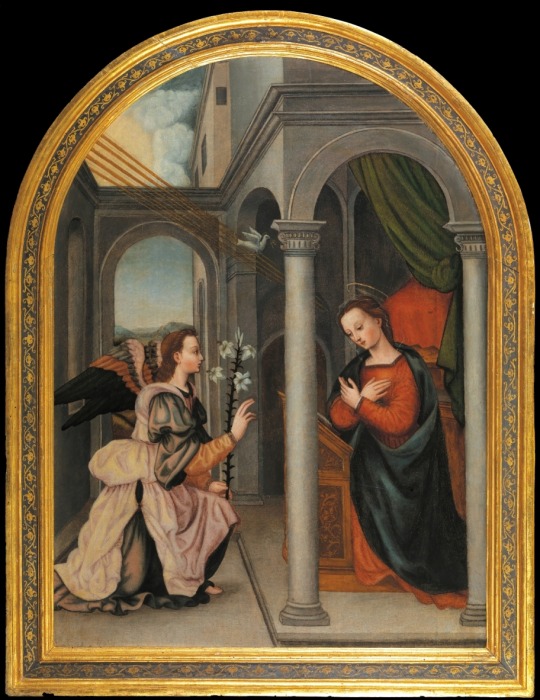
Plautilla Nelli (Italian, 1524-1588)
Annunciazione
110 notes
·
View notes
Text

Plautilla Nelli, The Last Supper, 1568, via Atlas Obscura
0 notes
Text
Le parole dell'amore. Ritratti di donne
Le parole dell’amore. Ritratti di donne
San Casciano in Val di Pesa, Firenze – Festa della Toscana 2021
Biblioteca Comunale, sabato 7 maggio 2022, ore 18
San Casciano in Val di Pesa, Firenze – La conferenza performance ideata e curata da Giovanna M. Carli per esprimere con forza il no ai linguaggi d’odio, in occasione della Festa della Toscana 2021, sarà presentata sabato 7 maggio 2022 alle ore 18.L’evento, organizzato dalla…
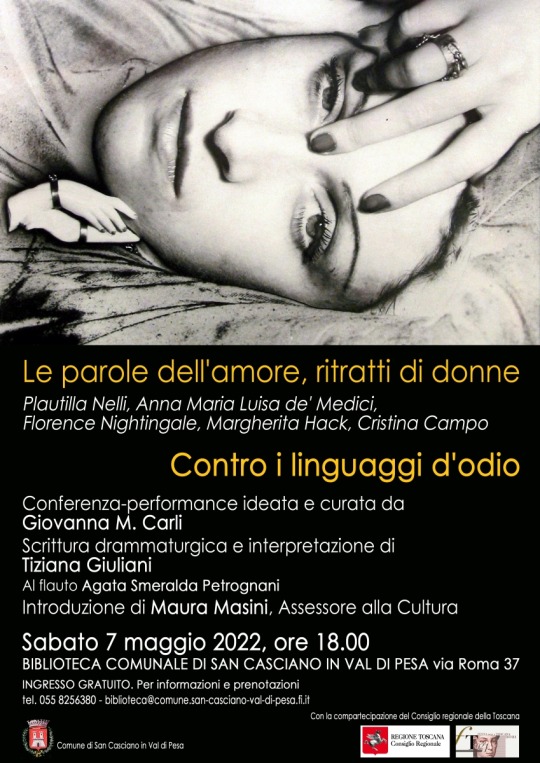
View On WordPress
#Agata Smeralda Petrognani#Anna Maria Luisa de&039; Medici#Biblioteca comunale di San Casciano in Val di Pesa#Consiglio regionale della Toscana#Contro i linguaggi d&039;odio#Cristina Campo#Festa della Toscana#Florence Nightingale#Giorgia Frosecchi#Giovanna M. Carli#Margherita Hack#Martina Ciani#Martina Ricci#Maura Masini#Parole d&039;amore#Ritratti di donne#Suor Plautilla Nelli#Tiziana Giuliani
1 note
·
View note
Text
Tien, is this you?

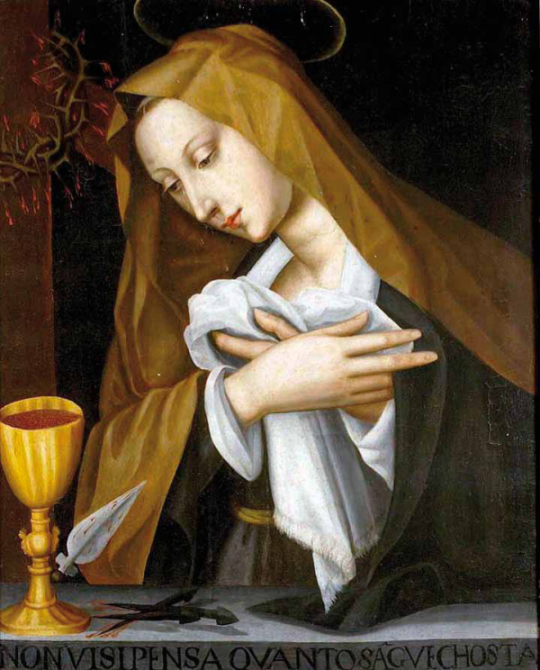
Music is Concerto for 2 Cellos (?)
The painting is Pained Madonna, 16th century by Plautilla Nelli
21 notes
·
View notes
Text
nobody could decide which stories they wanted me to share. they want me to share all of them 😭😭
i’ll start with jesus and john and why i think they’re gay for each other, supported by biblical evidence provided by Seton Catholic Homeschooling of America.
• i took this course in my tenth grade year. i was only homeschooled for 9th and 20th grade. i was public schooled before then, and later went to boarding school for my last two years of hs. but that’s another post.
this is a long post. buckle in. i’ll have it all below the cut
• i no longer have the textbook title, and only have pictures from this text book that i took in a delusional haze when reading this in my catholic mother’s household, hoping that she wouldn’t look through my phones photos to find these images.
this is all from a catholic standpoint, other forms of christianity are not accounted for. if you do not want to see GAY CONTENT ABOUT JESUS, move along
this post is about to unlock so much of my old hyperfixation on the catholic church that i had before leaving.
first of all, as backstory for those who don’t know john:
• john is one of jesus’ twelve disciples and wrote the Gospel of John (I, II, and III) which is a hella important book in the new testament (the second half of the bible.)
• the books of john tell the story of jesus’ life from birth to death. now, that’s kinda gay to write about another man that much, hmm.
• john has also earned the affectionate title of: “The Beloved Disciple”
• he is also traditionally credited with writing Revelations (also known as Apocalypse, which tells how the world is gonna end. fun right!!), though scholars are unsure if he wrote it, or a different john wrote it.
okay, now onto the gay stuff:
• most people jokingly ship judas and jesus because of the angst of judas’ betrayal to jesus. however, i disagree.
• though, knowing their ages, shipping jesus and john would be quite problematic these days, it was quite an acceptable age gap back then. jesus was around the ages of 30-33 at the time of his death, and john was a young adult, about 18. (yikes)
• my evidence begins with the way john writes about himself and jesus in the Gospel of John. in his gospel, he never calls himself john. you guys know what he calls himself in his gospel?? “the discipline whom jesus loved”
😐
sir. could you be ANY more obvious??
so far, all of this info is directly from my catholic textbook.

WOW! that page unpacks a lot. let me elaborate on the way john leaned up on jesus’ chest. first of all, that’s a real bible quote. let’s go:
John 13:23-25
• “23 One of his disciples, the one Jesus loved, was at the table to the right of Jesus in a place of honor. 24 So Simon Peter gestured to this disciple to ask Jesus who it was he was referring to. 25 Then the disciple whom Jesus loved leaned back against Jesus’ chest”
the passage then goes on to john (the disciple whom jesus loved) asking jesus who’s gonna betray him.
• to FURTHER add to this gay af moment, there are PAINTINGS of it, completed by MULTIPLE artists. i’m going to provide the image in my textbook, and then images found online that i particularly enjoy.

above: lovely image! i cannot remember the artist for the life of me.

above: Jesus and John at the Last Supper by Valentin de Boulonge
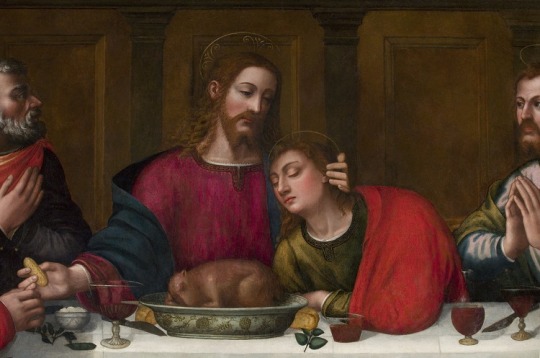
above: Last Supper by Plautilla Nelli (portions of the image were cropped)

above: cannot find artist’s name.
• if you are interested in finding hundreds more of images like this, all you need to type into google is “john leaning on jesus”. you’ll get the images you need. trust me
• those were my largest pieces of evidence, but there are smaller ones i’d like to share. the textbook helped “gay it up”. i think the author of this textbook was a closeted homosexual. cause no way did a straight person write this thinking “hmmm that’s totally platonic and not at all queer, cause that’s how i feel about MY best friend.”
here’s direct textbook images:

• hmmm man who was closest to him you say???
• “intimate relationship with God”
• best friend? 🤔 are we sure about that?
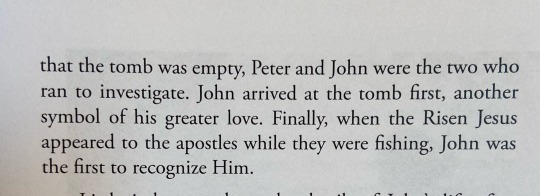
• symbol of his greater love?
• AND he was the first to recognize jesus??
• y’all. they’ve got to be shitting me atp. no way were they not In Love
and finally, from my study questions:

y’all. special favors? exceptional love?
this textbook had me GOBSMACKED. jaw DROPPED. WDYM THAT JESUS AND JOHN WERE DEFINITELY IN LOVE???
conclusion:
• i HIGHLY recommend you looking up more pictures of john laying on jesus.
• i think of john/jesus as canon. there’s too much evidence to support my point. including The Bible. judas/jesus is like what fanfics are for. they’re the pair that everyone wishes happened in canon, but the authors sucked, so it didn’t.
• literally, drop any questions in the reblogs and comments. i’ll be HAPPY to answer.
(and jesus/judas shippers, i hope i changed your mind.)
#bible#catholic#christianity#catholiscism#jesus x john#jesus christ#jesus x judas#anti catholic#anti christianity#(putting those in so catholics can filter this post out)#last supper#valentin de boulogne#apostle
6 notes
·
View notes